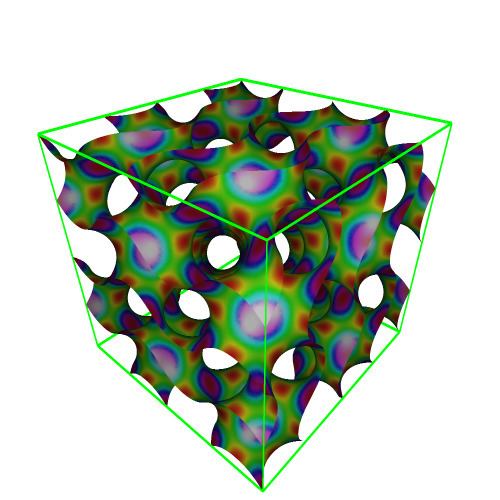 | ||
A gyroid is an infinitely connected triply periodic minimal surface discovered by Alan Schoen in 1970.
Contents
History and properties
The gyroid is the unique non-trivial embedded member of the associate family of the Schwarz P and D surfaces with angle of association approximately 38.01°. The gyroid is similar to the Lidinoid. The gyroid was discovered in 1970 by NASA scientist Alan Schoen. He calculated the angle of association and gave a convincing demonstration pictures of intricate plastic models, but did not provide a proof of embeddedness. Schoen noted that the gyroid contains neither straight lines nor planar symmetries. Karcher gave a different, more contemporary treatment of the surface in 1989 using conjugate surface construction. In 1996 Große-Brauckmann and Wohlgemuth proved that it is embedded, and in 1997 Große-Brauckmann provided CMC variants of the gyroid and made further numerical investigations about the volume fractions of the minimal and CMC gyroids.
The gyroid separates space into two oppositely congruent labyrinths of passages. The gyroid has space group Ia3d. Channels run through the gyroid labyrinths in the (100) and (111) directions; passages emerge at 70.5 degree angles to any given channel as it is traversed, the direction at which they do so gyrating down the channel, giving rise to the name "gyroid". One way to visualize the surface is to picture the “square catenoids” of the P surface (formed by two squares in parallel planes, with a nearly circular waist); rotation about the edges of the square generate the P surface. In the associate family, these square catenoids “open up” (similar to the way the catenoid “opens up” to a helicoid) to form gyrating ribbons, then finally become the Schwarz D surface. For one value of the associate family parameter the gyrating ribbons lie in precisely the locations required to have an embedded surface.
The gyroid refers to the member that is in the associate family of the Schwarz P surface, but in fact the gyroid exists in several families that preserve various symmetries of the surface; a more complete discussion of families of these minimal surfaces appears in triply periodic minimal surfaces.
Curiously, like some other triply periodic minimal surfaces, the gyroid surface can be trigonometrically approximated by the equation:
The gyroid structure is closely related to the K4 crystal (Laves' graph of girth ten).
Applications
In nature, self-assembled gyroid structures are found in certain surfactant or lipid mesophases and block copolymers. In the polymer phase diagram, the gyroid phase is between the lamellar and cylindrical phases. Such self-assembled polymer structures have found applications in experimental supercapacitors, solar cells and nanoporous membranes.
Gyroid membrane structures are occasionally found inside cells.
Gyroid structures have photonic band gaps that make them potential photonic crystals. Gyroid structures have been observed in biological structural coloration such as butterfly wing scales, inspiring work on biomimetic materials. The gyroid mitochondrial membranes in tree shrew cones might have an optical function.
In 2017, MIT researchers studied the possibility of using the gyroid shape to turn bi-dimensional materials, such as graphene, into a three-dimensional structural material with low density yet high tensile strength.
